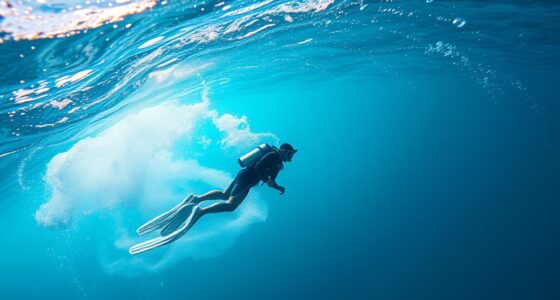When paddling near wildlife, avoid startling animals by approaching quietly and keeping a respectful distance. Keep your noise low and minimize sounds that could scare or stress animals, especially around water. Move slowly and thoughtfully to prevent alarm and give creatures space to retreat if they wish. Follow local rules and signs to protect vulnerable species and habitats. Staying mindful and respectful makes sure you support natural behaviors; if you look closer, you’ll discover even more ways to paddle responsibly.
Key Takeaways
- Maintain a respectful distance and avoid sudden movements to prevent disturbing wildlife.
- Keep noise levels low to minimize stress and avoid scaring animals away.
- Approach animals slowly and cautiously, giving them space to retreat if desired.
- Follow local regulations and signage to protect vulnerable species and habitats.
- Practice mindful paddling and genuine respect to foster ethical and sustainable wildlife interactions.

When you encounter wildlife in their natural habitat, practicing proper etiquette is essential to protect both the animals and yourself. One of the most important aspects of wildlife etiquette is respectful observation. You should always approach animals quietly and cautiously, avoiding sudden movements that could startle them. Keep your distance to prevent causing stress or disturbance, and use binoculars or a camera with a zoom lens to get a closer look without intruding. Respectful observation shows you value the animals’ space and well-being, which helps maintain their natural behaviors and habitats.
Respect wildlife by approaching quietly, keeping your distance, and using zoom tools to observe without disturbance.
Noise management is equally critical when observing wildlife. Many animals are sensitive to sound, and loud noises can scare or stress them, potentially causing them to abandon their nests or young. As a paddler, you might be tempted to speak loudly, play music, or make other noises that disturb the environment. Instead, keep your voice low and minimize unnecessary noise. If you’re paddling in a group, coordinate to remain quiet and avoid shouting or loud conversations. Remember, even small sounds can carry far across water, so being mindful of noise helps preserve the tranquility of the habitat and keeps wildlife undisturbed.
Practicing respectful observation and managing noise go hand-in-hand. When you respect animals’ space, you’re less likely to spook them, and quiet behavior enhances your chances of witnessing their natural activities. Avoid sudden paddling maneuvers or splashing that might alarm nearby creatures. If you see animals, slow down and approach with caution, giving them plenty of room to move away if they choose. This not only prevents stress but also allows you to observe more authentic behaviors, enriching your experience without negatively impacting the environment.
It’s also essential to adhere to local guidelines or regulations about wildlife viewing. Many areas have specific rules to protect sensitive species, and ignoring these can lead to harm or disturbance. Always research before your trip, and follow posted signs or instructions from park authorities. Remember, your goal is to enjoy and appreciate wildlife without interfering with their daily lives. By practicing respectful observation and noise management, you’re helping to sustain the natural balance and ensure future generations can experience the same beauty.
Additionally, understanding the importance of emotional intelligence can greatly enhance your ability to connect ethically with wildlife and fellow paddlers alike. In essence, mindful paddling involves patience, quietness, and a genuine respect for the creatures you encounter. When you prioritize these principles, you not only protect the wildlife but also deepen your connection with nature. Your respectful approach fosters a more meaningful and ethical outdoor experience, allowing you to witness wildlife in their purest form while preserving their habitat for years to come.
Frequently Asked Questions
How Close Is Too Close When Observing Wildlife From a Kayak?
When observing wildlife from your kayak, you might wonder about wildlife distance—how close is too close? As a paddler, you need to maintain respectful paddler awareness, keeping your distance to avoid disturbing animals. Generally, staying at least 50 yards away is best. Use slow, quiet movements and avoid sudden actions. By respecting wildlife distance, you ensure animals remain undisturbed and your experience stays safe and enjoyable.
Should I Feed or Attract Animals During Paddling Trips?
You shouldn’t feed wildlife or try to attract animals during your paddling trips. Feeding wildlife can make animals dependent on human food, disrupting their natural behaviors and diets, and attracting them closer to boats can be dangerous for both you and the animals. Instead, observe from a respectful distance and enjoy their natural beauty without interfering. Let wildlife come to you naturally, ensuring a safe and respectful paddling experience.
What Should I Do if I Encounter a Distressed or Injured Animal?
When you spot a distressed or injured animal, compassion clashes with caution. First, stay calm and keep your distance to avoid causing further stress. Follow rescue protocols by gently documenting the situation and immediately reporting it through proper channels. Do not attempt to move or treat the animal yourself. Your responsible actions help guarantee the animal receives expert care, and reporting procedures ensure it gets the help it needs.
Are There Specific Times of Day Better for Wildlife Viewing?
You’ll have the best wildlife viewing during the early morning or late afternoon when the lighting is ideal, providing the best lighting for spotting animals and capturing photos. These times also coincide with peak activity, as many creatures are most active during dawn and dusk. Paddling during these periods increases your chances of observing wildlife naturally, while also respecting their routines and minimizing disturbance.
How Can I Minimize Noise Pollution While Paddling?
Did you know loud noises can disrupt wildlife for hours? To minimize noise pollution while paddling, practice silent paddling by moving slowly and avoiding sudden sounds. Keep a respectful distance from animals, which helps reduce stress on them and keeps your experience peaceful. Using soft paddles and communicating quietly with your group also helps. Respectful distance and silent paddling make sure you observe wildlife without disturbing their natural behavior.
Conclusion
So, next time you paddle out, remember these wildlife etiquette rules—because ignoring them might just make you the biggest threat to the very creatures you’re there to enjoy. Ironically, your efforts to get closer for the perfect shot could scare away the wildlife forever. Respect their space, stay quiet, and keep your distance. After all, the best wildlife encounters happen when you’re a humble visitor, not a reckless intruder. Happy paddling—and leave nature undisturbed!










